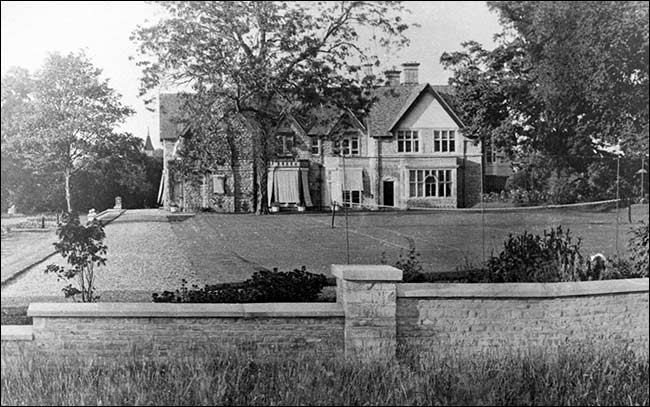|
|||
| From the archive of Rowan Flack Former Clinical Nurse Officer, Rushden Hospital, 1966-1990. Transcribed by Greville Watson, 2008 |
|||
|
Rushden House - Second Period
Browning |
|||
|
|||
|
In order to satisfy the requirements of continuity it is necessary to remember that Mrs Currie died in 1901. That sad event took place at the end of the year and therefore it is reasonable to assume that some time would have passed before the house was put up for sale. Mr Browning and family were in residence at Knuston Hall, some four miles away on the way to the It is known that Mr Browning, according to the newspapers of the time, extensively enlarged and beautified the house, and again there is photographic evidence to show that some of this work was carried out between 1903 and 1904. The total alterations however, were not completed until 1907 where the date, on the outside of the drawing room can be seen to this day. The building project was really of immense proportions. The North Wing had been extended, from top to bottom, to provide a sitting room for the servants on the ground floor, and above that, a lovely room where the family could meet informally, and where the girls could occupy themselves with needlework and the like. The extra room at the top would allow for more servant accommodation. The single porch had been made into two porches, the door in the right hand side and probably a cloakroom in the left with a door leading from just inside the right-hand porch entrance. The south west front must really be considered as the front of the house. A whole new block had been built by 1904. A beautiful billiard room on the ground floor, and guest accommodation on the first floor. This new extension was of one storey only. Further disruption was to come, and by 1907 the drawing room had been extended with a new bedroom for Mr Browning above with a small balcony looking out onto the tennis court. The dining room had also been extended. The smoking room only needed the addition of a conservatory to complete the whole project. The gardens would receive attention next and Mr Browning had many ideas in regard to the layout and in particular to the planning of the rose gardens and the ‘ I have not been able to collect sufficient information in regard to the Currie family to be able to give a factual account of the interesting happenings of that time, even though their period of occupation was at least three times as long as the Browning era; but from 1904 until 1914 the facts are much more readily available and in order to do justice to the situation it is necessary to give an account of the family with as much detail as possible. Edward Campbell Browning Born in 1836 Edward Campbell Browning was the second son of Henry Browning of In 1873 he married Alice Louisa, daughter of Mr James Pratt-Barlow, or Hyde Park Gate, Having been a Partner in the firm of Twiss and Browning for some years, Mr Browning retired in 1897 and resided at Knuston Hall, Irchester, for some five or six years before purchasing Rushden House in Rushden, Northamptonshire. He did a great deal of shooting and was an excellent shot. His keenness in cricket was such that he became Vice President of the Rushden Cricket Club, and he displayed a great interest in the welfare of the Boy Scout movement and the Rushden Scouts received many proofs of his thoughtfulness and goodwill. In 1905 Mr Browning was placed upon the Commission of the Peace for the Of the marriage there were two sons and four daughters. Robert Campbell Browning The first son was born in 1875 and was also connected to the firm of Twiss and Browning, Wine & Spirits merchants. He married Monica Bucknall in 1901, and they had three daughters, Diana, Cressida and Dorothy. They resided at ‘Old Wolverton House’, Wolverton, Buckinghamshire. James Alexander Browning The younger son was born in 1878 and was educated at Eton and In 1903 he married Lilian Brenda Fisher, daughter of Captain John Basil Fisher, and niece of Mr W.Hirst Simpson BA CC of Chelveston, the Town Clerk of Higham Ferrers, with whom she used to reside. The wedding took place in St.Mary’s Church, Higham Ferrers. There were two sons of this marriage, namely, Geoffrey and Peter. Major Browning resided at various places convenient to his posting, including Hounslow, Aldershot, and also at Brook Farm, Great Plumstead, near Alice Maude Mattie Browning The eldest daughter married Francis Joseph Simpson, Town Clerk of Higham Ferrers in 1902. There were two children of this marriage, Jim and Nancy Josephine. |
|||
|
|
|||
|
|
